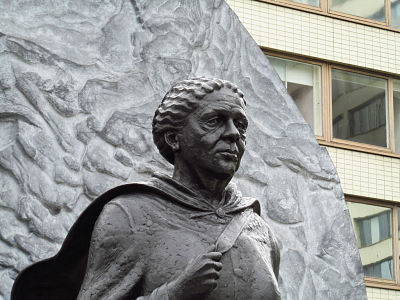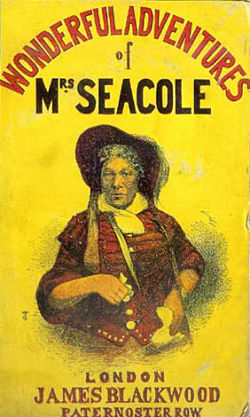Black History and the Myth of Mary Seacole
In 1964, Elvi Whittaker and Virginia Olesen, social scientists at the UCSF School of Nursing, published a paper examining the mythologizing of Florence Nightingale. They took up anthropological work on the way in which clan groups in traditional societies were bound together by stories about their descent from a common ancestor. The ancestor figure stayed constant while the stories evolved to fit the changing circumstances of the group. They used the same approach to analyse contemporary professions.
The transformation of US nursing into a graduate occupation was accompanied by a reworking of the stories told about Florence Nightingale. The ‘Lady of the Lamp,’ mopping the brows of fevered soldiers in the Crimean War (1853-56), gave way to the public health reformer and statistician. The continuity of the profession was marked by the continuity of references to its iconic heroine: its evolution, in response to changes in medical technology, disease patterns and the division of labor, was marked by a shift that emphasized different aspects of the historical record of Miss Nightingale’s career. Nurses were still her successors, even if they were less engaged in hands-on care.
The adoption of the white daughter of a relatively well-off family as this profession’s icon has had mixed consequences. The persistence of the ‘Lady of the Lamp’ version in lay circles leads to repeated denigration of the intellectual demands made on modern nurses. Journalists and politicians perpetuate the belief that any nice girl, however dim, who cares enough can be a nurse. It was never an accurate image of the nursing workforce beyond a few elite hospitals. As British nursing developed in the late 19th century, it recruited the daughters of small farmers and lower-middle class or ‘respectable working class’ families. It also drew in a lot of young migrant women from Ireland and, after World War II, from the Caribbean and other former colonies. These women often suffered poor treatment and discrimination within the profession.
It is, then, understandable that black nurses have sought to identify an icon of their own to reflect their immense contribution. What is unfortunate is their choice, a Jamaican-born woman called Mary Seacole (1805-81). Mrs Seacole wrote an autobiography which was published in 1857. This memoir was written as part of a fund-raising campaign, when she was bankrupt, and should be read in that context. However, its narrative of her Crimean experiences is confirmed in most key respects by other sources.
By her own account, Mrs Seacole travelled to England early in 1854 to pursue investments that she had made in gold mining shares, using the profits from earlier grocery and hospitality businesses in Jamaica and Panama. The shares proved to be worthless and she conceived the project of going to the Crimea, where some of the regiments she had traded with in Jamaica were now fighting. Initially, it seems that she did indeed try to go in some kind of nursing capacity but the two parties recruited to work under Miss Nightingale’s supervision had already left. The relevant government departments were not interested in recruiting more women. She formed a different project, of establishing a ‘British Hotel’ where officers could convalesce and which would also sell provisions, including home remedies. She went to the Crimea with her business partner at the end of 1854, after the bloodiest part of the campaign. In the event, she never provided accommodation and contemporary accounts describe the business as a combination between a tavern, a café and a grocery store, housed in a couple of iron huts. When there was a battle, she went off to sell wine and sandwiches to the spectators. It may seem odd today but battles at this period were spectator sports –fashionable Washington society drove out to watch the early battles of the American Civil War, for example. After the battles she helped to search for wounded or dying soldiers, occasionally with stray bullets or shells flying around.
Mrs. Seacole’s memoir forms the main basis of her transformation into an icon of nursing since the 1980s. University buildings, scholarships, and hospital wards have been named for her. Nursing textbooks celebrate her alongside Florence Nightingale The study of her life and work has been inserted into the National Curriculum used in English high schools. Historic markers have been placed on buildings in London where she lived and a statue has been erected. Her life has been featured in television programmes for a variety of audiences.
Unfortunately, there is really nothing in the historical record to justify any of this. This has been dissected in detail by the Canadian sociologist Lynn McDonald, but here are two brief examples.
First, Mrs. Seacole never describes herself as a nurse in the sense of someone who is a member of a distinctive occupation associated with the care of sick or injured people in an institutional environment. She writes about herself as a ‘doctress, nurse and mother,’ but her references to nursing are linked to domestic settings, where most 19th century women would have provided care of sick family members. She never contributed to the ‘new profession for women’ envisaged by Florence Nightingale.
Second, Mrs. Seacole underlines the differences between her role and that of Miss Nightingale. She describes one friendly encounter where Miss Nightingale found her a bed for the night despite the overcrowding in the hospital and she writes acutely about the conditions there and the stress on the nurses. Alexis Soyer, the Jamie Oliver of his day, who knew both women, records carrying mutual good wishes between them. They were not competitors for credit because they were doing different things.
Mrs. Seacole might be celebrated as a black entrepreneur. For much of her life, until her health failed, she was a successful businesswoman and an adventurous traveler. Her kindness and generosity are well-documented. They are reflected in the support for two public appeals when she fell on hard times. In the way of her business, she sold a variety of home and patent remedies, as many grocers did before English pharmacy began to be regulated in 1852. She certainly provided the kind of domestic nursing and first aid that women have done since time immemorial. But this does not make her a founder of nursing as a profession.
This case is, in some ways, the obverse of the present controversies over people like Cecil Rhodes and John Calhoun, where the complexities of the historical record are lost in conflicts about iconography. The contemporary universities and hospitals that have rushed to adopt Mary Seacole really should have had more respect for historical scholarship in attempting to address their own concerns about diversity. There are more genuine black heroines like Kofoworola Abeni Pratt (c.1910-1992), who is believed to have been the first black nurse to work in the English National Health Service, was active in anti-colonial movements, and played a central role in the decolonization of Nigerian nursing. Too many people who ought to know better have preferred to print the legend rather than respect the evidence.


























































































How long before blm have this article removed as racist